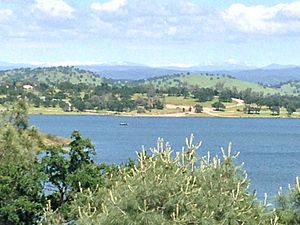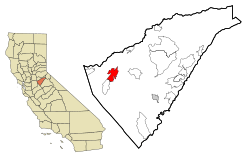Valley Springs, California facts for kids
Quick facts for kids
Valley Springs
|
|
|---|---|

New Hogan Lake, Valley Springs
|
|

Location in Calaveras County and the state of California
|
|
| Country | |
| State | |
| County | Calaveras |
| Area | |
| • Total | 9.875 sq mi (25.579 km2) |
| • Land | 9.872 sq mi (25.570 km2) |
| • Water | 0.003 sq mi (0.009 km2) 0.04% |
| Elevation | 669 ft (204 m) |
| Population | |
| • Total | 3,553 |
| • Density | 359.80/sq mi (138.903/km2) |
| Time zone | UTC-8 (Pacific) |
| • Summer (DST) | UTC-7 (PDT) |
| ZIP codes |
95226, 95252
|
| Area code | 209 |
| FIPS code | 06-81890 |
| GNIS feature IDs | 1660090, 2409398 |
| Reference #: | 251 |
Valley Springs, once known as Spring Valley and Valley Spring, is a special type of community in Calaveras County, California. It's called a census-designated place (CDP), which means it's an area identified by the United States Census Bureau for statistics. Valley Springs is located in the beautiful foothills of the Sierra Nevada Mountains. It's also recognized as a California Historical Landmark, number 251, showing its importance in history.
History of Valley Springs
Early Inhabitants and Gold Rush Impact
Long ago, Native American tribes lived in the Valley Springs area. Evidence like grinding rocks shows that the Mi-Wuk and Yokuts tribes were here. They collected acorns for food and trade. Later, gold miners arrived, and the Mi-Wuk people moved deeper into the mountains.
In 1849, the first store and saloon opened in Valley Springs. Small farms and large ranches grew to feed the new settlers. Places for travelers to stop, called stage stops, appeared along what is now Highway 26. Roads also improved, connecting Valley Springs to nearby areas.
The Arrival of the Railroad
People needed faster and cheaper ways to move goods and travel. This led to the expansion of railways. On April 25, 1885, the first train arrived at the Valley Springs station. At first, the station was just a tent! Valley Springs quickly became a key place for moving freight. Residents could reach San Francisco in about 7.5 hours by train. Stockton was 2.5 hours away, and Sacramento was 3 hours.
In September 1895, a large fire destroyed most of the central town. This fire, along with the railroad not expanding as much as hoped, caused problems for Valley Springs.
Rebuilding and Growth in the 20th Century
Even after rebuilding, Valley Springs grew slowly for a while. The population increased by less than 1% each year. Even getting electricity in 1899 and the railway changing to a standard-gauge line didn't boost growth much. From 1910 to 1930, the number of residents actually went down.
A big change happened in 1925 when the Calaveras Cement Company needed to transport its products. The railway expanded, helping with the building of the Pardee Dam. It also helped ship cement directly to places like the San Francisco Bay Area. Many important structures were built using cement from Valley Springs. These include the McClellan Air Force Base, Travis Air Force Base, San Francisco International Airport, and the San Francisco–Oakland Bay Bridge.
The Calaveras Cement Company and the construction of the Hogan Dam and Pardee Dam created many jobs. Shipping needs grew for local lumber, forest products, cement, and clay. Farming remained important, with residents focusing on grains, livestock, and small amounts of wine grapes and olives. Valley Springs' location was very important for its success.
Modern Development and Population Changes
In the 1930s and 1940s, Valley Springs' population grew by about 6% each year. Growth slowed in the 1950s but picked up again in the 1960s. This was thanks to the development of the Camanche Reservoir and the expansion of the Hogan Reservoir.
The 1970s saw more population growth due to new communities like Rancho Calaveras and the La Contenta Golf Course. Even though major manufacturing businesses closed in the 1980s, Valley Springs continues to grow. For many decades, it has helped develop major cities in California's central valley and bay areas.
In 1885, the San Joaquin and Sierra Nevada Railroad finished building a narrow-gauge railroad to Valley Springs. This line later became part of the Southern Pacific Railroad. A post office opened in Valley Springs in 1872, closed in 1879, and then reopened in 1882.
Geography and Climate
Location and Land Area
Valley Springs is located in Calaveras County, California. According to the United States Census Bureau, the total area of this community is about 9.9 square miles (25.6 square kilometers). Almost all of this area, about 99.96%, is land.
Understanding Valley Springs' Climate
Valley Springs has a Mediterranean climate, which is common in the foothills of the Sierra Nevada Mountains.
- Winters are cool and wet. Days are mild, nights are chilly, and there is a good amount of rain.
- Summers are hot and dry. Days are very hot, nights are cool, and there is very little rain.
- Because of something called the orographic effect, Valley Springs gets much more rain than the flat valley areas to its west.
| Climate data for United States | |||||||||||||
|---|---|---|---|---|---|---|---|---|---|---|---|---|---|
| Month | Jan | Feb | Mar | Apr | May | Jun | Jul | Aug | Sep | Oct | Nov | Dec | Year |
| Mean daily maximum °F (°C) | 53 (12) |
59 (15) |
63 (17) |
69 (21) |
79 (26) |
88 (31) |
94 (34) |
93 (34) |
88 (31) |
77 (25) |
62 (17) |
53 (12) |
73.2 (22.9) |
| Daily mean °F (°C) | 46.0 (7.8) |
50.5 (10.3) |
53.5 (11.9) |
58.0 (14.4) |
65.5 (18.6) |
72.5 (22.5) |
76.9 (24.9) |
78.0 (25.6) |
73.5 (23.1) |
65.0 (18.3) |
53.5 (11.9) |
46.0 (7.8) |
61.6 (16.4) |
| Mean daily minimum °F (°C) | 39 (4) |
42 (6) |
44 (7) |
47 (8) |
52 (11) |
57 (14) |
62 (17) |
62 (17) |
59 (15) |
53 (12) |
45 (7) |
39 (4) |
50.1 (10.1) |
| Average precipitation inches (mm) | 4.13 (105) |
3.86 (98) |
3.82 (97) |
2.01 (51) |
1.18 (30) |
0.28 (7.1) |
0 (0) |
0.04 (1.0) |
0.43 (11) |
1.3 (33) |
2.68 (68) |
3.74 (95) |
23.47 (596) |
Summers are usually very warm to hot. Spring and fall seasons have mild temperatures. Winters are cool, sometimes with a light dusting of snow or frost. The hot, dry summers mean Valley Springs can be prone to fires. However, three fire stations, lake water, and good road access help put out fires quickly.
Population and People
Demographics of Valley Springs
As of the 2010 United States Census, the total population of Valley Springs is 3,553 people. The population is almost evenly split between males and females. There is one more male than female residents in the community.
See also
 In Spanish: Valley Springs (California) para niños
In Spanish: Valley Springs (California) para niños


